
The Curculionidae are a family of weevils, commonly called snout beetles or true weevils. They are one of the largest animal families, with 6,800 genera and 83,000 species described worldwide. They are the sister group to the family Brentidae.
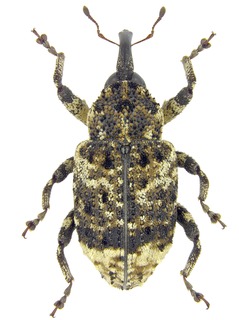
Cryptorhynchinae is a large subfamily of weevils (Curculionidae), with some 6000 species. They are found in most zoogeographic regions although they are most diverse in the Neotropics, Australia and Oceania.

Aciphylla colensoi is a species of Aciphylla, commonly known as giant speargrass, Spaniard, or its Māori-language name taramea. Individual plants may be up to 90 cm (35 in) in diameter and half as high, and consist of sharp spines, all pointing out from the centre. Yellow flowers may also be present, located on long, strong stems. A. colensoi can be found in both main islands of New Zealand, typically in altitudes from 900 to 1,500 m.
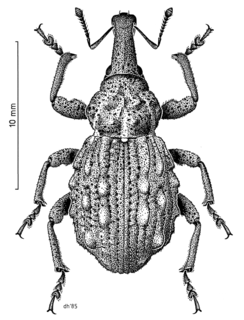
Hadramphus tuberculatus is a rare weevil endemic to Canterbury in the South Island of New Zealand. It was thought to be extinct in 1922 but was rediscovered in 2004.

Hadramphus, commonly known as knobbled weevils, is a genus of flightless molytine weevils from the family Curculionidae. It is endemic to New Zealand and consists of four species.
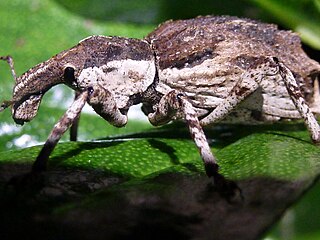
Anagotus stephenensis, commonly known as the ngaio weevil, is a large flightless weevil that is only found on Stephens Island in New Zealand. The ngaio weevil was discovered in 1916 by A.C. O'Connor on Stephens Island. Thomas Broun described it in 1921 as Phaeophanus oconnori after its collector. The weevils were observed at the time to be 'feeding on tall fescue and the leaves of trees'.

Anagotus fairburni or flax weevil is a large flightless weevil. It feeds on leaves of New Zealand flax species where it produces a characteristic feeding notch. It is found on islands and in alpine areas of New Zealand.

Aciphylla aurea is a species of Aciphylla, commonly known as golden speargrass or golden Spaniard. Individual plants may be up to 100 cm (39 in) tall, and consist of sharp spiky yellowish-green leaves. A. aurea is found throughout the South Island of New Zealand, usually in mountainous areas but also lower altitude dry well drained grassland sites. It is found at altitudes of 300 to 1,500 m.

Trigonopterus argopurensis is a species of flightless weevil in the genus Trigonopterus from Indonesia.

Trigonopterus echinatus is a species of flightless weevil in the genus Trigonopterus from Indonesia.
Cerius otagensis is a species of flightless fungus weevil that is endemic to New Zealand. It has been found in only two locations in the Central Otago region.

Hadramphus spinipennis, commonly called the coxella weevil, is a large, nocturnal, flightless weevil only found on Mangere and Rangatira Islands in the Chatham Islands, New Zealand.

Dasyuris partheniata is a species of moth in the family Geometridae. It is endemic to New Zealand. It is classified as "At Risk, Declining" by the Department of Conservation.

Lyperobius huttoni is a New Zealand weevil found in alpine areas of the South Island and at sea level around the Wellington coast. It feeds only on speargrass (Aciphylla). Weevils from the endangered Wellington population have been translocated to predator-free Mana Island.

Lyperobius is a weevil genus in the subfamily Molytinae. Most Lyperobius species live in sub-alpine and alpine grassland, feeding on members of the family Apiaceae. Adults are active by day and feed on flowers, seeds, leaves and stems of the host plant. Larvae are found in the thick roots, rhizomes and soil surrounding the root system. All members of this genus are endemic to New Zealand. With the exception of L. huttoni and L. nesidiotes, all species are only found on the South Island.
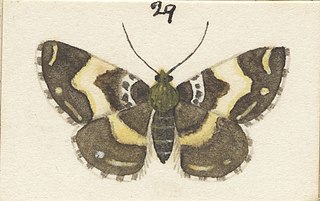
Notoreas galaxias is a species of moth in the family Geometridae. This species is endemic to New Zealand.

Notoreas arcuata is a species of geometer moth endemic to New Zealand.

Lyperobius hudsoni is a flightless weevil found in alpine areas of Central Otago and Otago Lakes in the South Island of New Zealand.
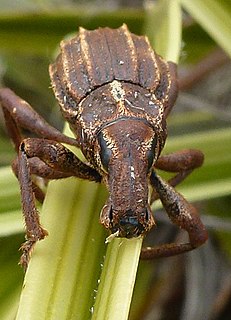
Anagotus oconnori or astelia weevil is a large flightless weevil found in New Zealand. It was first collected on Mount Quoin in Wellington from Astelia by Mr A.C. O'Connor after whom this species was named.

Paranotoreas ferox is a species of moth in the family Geometridae. This species is endemic to New Zealand. This species was first described by Arthur Gardiner Butler in 1877 and named Fidonia ferox. In 1986 Robin C. Craw placed this species within the genus Paranotoreas.




















